5 Major U.S Aircraft Carrier Museum Ships
The U.S Aircraft Carrier Museum Ships stand as a testament to the military power and capabilities of the U.S Naval Force. These behemoths were once at the forefront of warfare, defeated their enemies and won several significant wars that altered the course of American history once and for all.
They are a vital part of the country’s naval heritage, and though they are old, they hold innumerable value; hence, they have been made into museums, awing visitors from across the world.
The 5 U.S Aircraft Carrier Museum Ships, which we will discuss further in this article, are symbols of the country’s resilience and victory. These vessels were far ahead of their time and also a step further compared to their counterparts.
The huge decks that once launched aircraft into the expansive skies are key to the bygone era, showcasing the technological advancements, the historical milestones, and the courage and sacrifice of the individuals who served on these magnificent ships.
There are 5 Aircraft Carrier Museum Ships in the U.S, namely-
- USS Hornet Museum; Alameda, California – USS Hornet (CV-12)
- Intrepid Sea, Air & Space Museum; New York City – USS Intrepid (CV-11)
- USS Lexington Museum on the Bay; Corpus Christi, Texas – USS Lexington (CV-16)
- USS Midway Museum; San Diego, California – USS Midway (CV-41)
- Patriots Point; Charleston, South Carolina – USS Yorktown (CV-10)
All the above-mentioned aircraft carriers date back to the Second World War Period. Among these, four aircraft carriers belong to the Essex class. The U.S constructed 24 of these during the war period. The fifth carrier is of the Midway-class constructed during the end of the war.
During those times, the aircraft carriers were small compared to the ones we have today, which are supercarriers and more technologically advanced with the world’s most lethal weapon systems.
Let’s look at the storied pasts, the global impact and the legacy of these majestic ships.
1. USS Hornet Museum; Alameda, California – USS Hornet (CV-12)
The 27,100-ton aircraft carrier USS Hornet was constructed at Newport News in Virginia to join the war efforts. She was commissioned in 1943 and subsequently assigned to the Fast Carrier Task Force, the Navy’s main offensive arm during the Pacific War.
USS Hornet left the Atlantic to tackle the Japanese forces in the Central Pacific. Hornet also took part in the Marianas invasion and the Battle of the Philippine Sea. She was nicknamed the Great Marianas Turkey Shoot for the great losses it inflicted on Japanese forces during the war. On 6th April 1945, her planes led to the skinking of the great Japanese battleship Yamato.
The ship continued its operations in Okinawa; however, her flight deck suffered damage in a typhoon, and it had to return to the U.S for repair work. The war ended by the time it could sail again, and so the carrier brought soldiers home to the U.S from the Pacific in 1945. She was put in reserve in 1946 and was reactivated in 1950 when the Korean War began.
She was modernised in the late 1950s and became an anti-submarine carrier, playing a part in the 1960 Vietnam War and the Apollo Program, where it recovered the capsule and the astronauts as they came back from the moon.
She was decommissioned in 1970 and was designated as a National Historic Landmark and a California Historical Landmark, eventually opening to the public as the USS Hornet Museum in Almeda, California, in 1998.
About the USS Hornet Museum
This historic museum ship or memorial ship lies on the southernmost berth of the earlier Naval Air Station in Almeda, California, in the United States.
The main attraction is the aircraft carrier USS Hornet. Still, there are other exhibits that attract a visitor’s attention, such as those from Apollo Moon Missio and also other World War II aircraft which have retired, including transonic and supersonic jets.
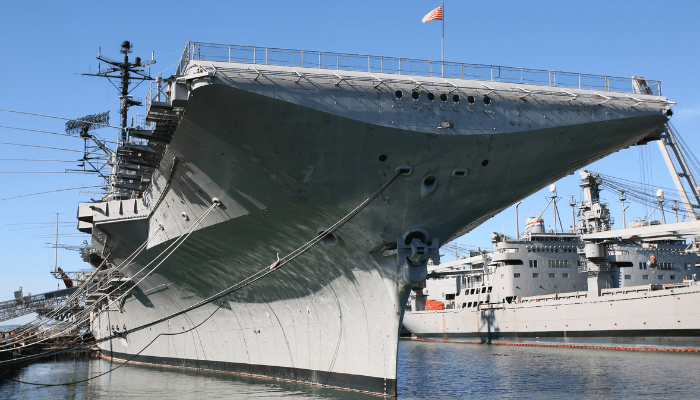
One can see jets, propellor aircraft, and rotorcraft from the 1940s to the 1980s displayed on the flight deck and hangar deck. These are often moved between decks after using Hornet’s aircraft elevator.
The other exhibits are displayed in designated compartments, and the ship’s hangar, flight deck and first deck are open for self-guided tours. One can go for Docent-led tours of the control areas and navigation deck, including the space housing 2 of the 4 ship’s propulsion turbines.
Museum Opening Time: The USS Hornet Museum remains open from Friday to Monday, 10:00 am to 5:00 pm, with the last entry permitted at 4:00 pm. It remains closed to the public on Thanksgiving, Christmas and New Year’s
Entry Price: Admission tickets are USD 20 for an adult. For seniors, students and military personnel, the ticket is for USD 15. Those aged between 7-17 can purchase the ticket for USD 10, while children aged 6 and under can enter without any fee. The same is applicable to members of the museum.
2. Intrepid Sea, Air & Space Museum; New York – USS Intrepid (CV-11)
Also called The Fighting I, the USS Intrepid aircraft carrier was constructed during World War II. It was commissioned in 1943 and went on to participate in several naval campaigns, including the Battle of Leyte Gulf.
She was decommissioned after the war ended. However, she was sent for modernisation to get it ready for its recommissioning in the 1950s as an attack carrier, eventually becoming an anti-submarine carrier.
She was then mainly deployed in the Atlantic but also went to participate in the Vietnam War. She also served as a recovery vessel for a Mercury and Gemini Space Mission.
Due to the losses inflicted on its enemies, she was named the Fighting I. She was attacked and hit by 4 Japanese kamikaze aircraft while she was in a dry dock undergoing repairs, which earned her the names Decrepit and Dry I.
She was decommissioned again in 1974, and in 1982, It was transformed into a museum ship.
About the Intrepid Sea, Air & Space Museum
One of the biggest museums of its kind in the world, it has several exhibits, the most important being the aircraft carrier USS Intrepid, Space Shuttle Enterprise, a Lockheed A-12 supersonic plane, cruise missile sub-USS Growler and much more.
It was reopened in 2008 after nearly 2 years of renovation and includes new exhibits, making it more fascinating. It has a wide range of aircraft, mostly naval aircraft like the F-16 Fighting Falcon.
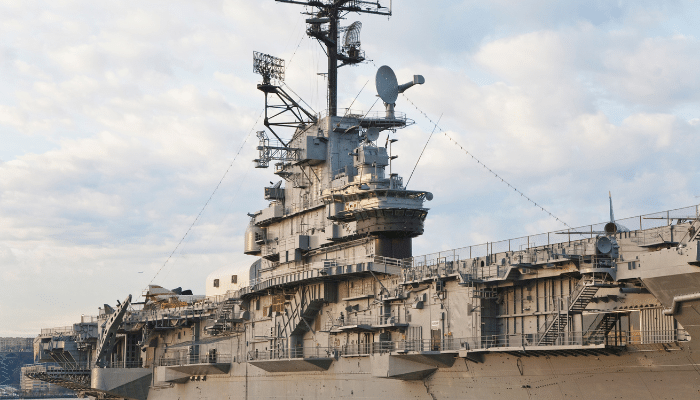
Museum hours: The Museum usually opens from Monday-Friday, 10:00 am to 5:00 pm.
On Saturdays, Sundays and holidays, it is open from 10:00 am to 6:00 pm, only from June- September. From October-May, it opens only on Saturdays, Sundays and holidays from 10:00 am to 5:00 pm.
Ticket Price: A single ticket costs USD 36 for those aged between 13 to 64. Seniors who are 65+ and students with valid ID need to pay USD 34. Tickets for children aged between 5-12 cost USD 26. Children aged 4 and below can enter the museum for free, and the same applies to Veterans and Military Service Members.
3. USS Lexington Museum on the Bay; Corpus Christi, Texas – USS Lexington (CV-16)
USS Lexington was initially going to be named Cabot; however, it was named to commemorate the lost US Lexington or CV-2. It became the 6th U.S. Navy vessel to bear the name in honour of the Battle of Lexington.
It was commissioned in 1943 and served during the Pacific War, acting as a flagship and leading the Fast Carrier Task Force across the Pacific. She received 11 battle Stars for her service and several other prestigious awards.
It was modernised and reactivated in the 1950s, then reclassified as an attack carrier, and later an antisubmarine carrier. In 1991, it was decommissioned with a longer service life compared to other Essex-class ships.
Then, it was donated to be converted into a museum ship, and in 2003, it was classed as a National Historic Landmark.
About the USS Lexington Museum
There are many attractions in this museum, such as the Flight Deck, the flight simulator, the Pearl Harbor exhibit, the mega theatre, scale models, virtual battle stations and much more. People can also enjoy overnight camping.
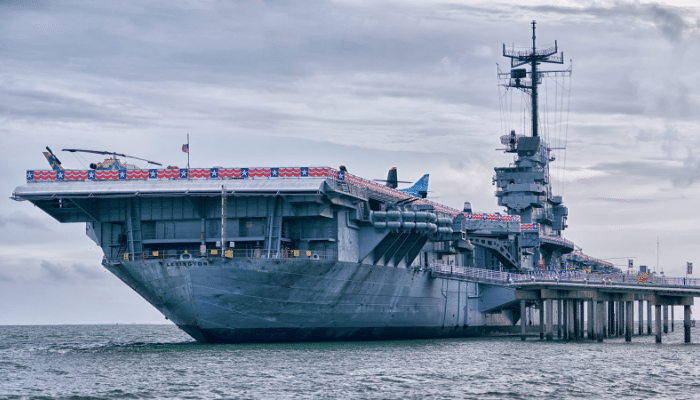
Opening times: The USS Lexington Museum opens from 9:00 AM to 5:00 PM from September to May and from 9:00 AM to 6:00 PM from May to September.
Ticket Price: Entry costs USD 18.95 for adults. Seniors aged 60 and older get a discounted ticket for USD 16.95. Youth aged between 13 to 17 need to pay USD 16.95, while tickets for children aged between 4-12 cost USD 13.95. Military members need to pay only USD 14.95. Parking fees amount to USD 5.
4. USS Midway Museum; San Diego, California – USS Midway (CV-41)
USS Midway was once the lead ship of her class and participated in numerous wars like the Vietnam War and Operation Desert Storm, where it served as a flagship. She was commissioned eight days after the Second World War ended and was the biggest ship in the world till 1955.
It was also the first U.S. Aircraft Carrier, which was too big to cross the Panama Canal at that time. She remained in service for 47 years, earned many badges of honours, and was decommissioned in 1992.
She was then made into the USS Midway Museum in San Diego, California, and remains the only inactive U.S. Aircraft Carrier that does not belong to the Essex-Class.
About the USS Midway Museum
The Museum has many interesting exhibits, such as those on the hangar deck, flight deck, below deck, the aircraft gallery, the TBD Devastator, etc. One can go on a guided tour called Midway Stories or even a Midway Virtual Tour.
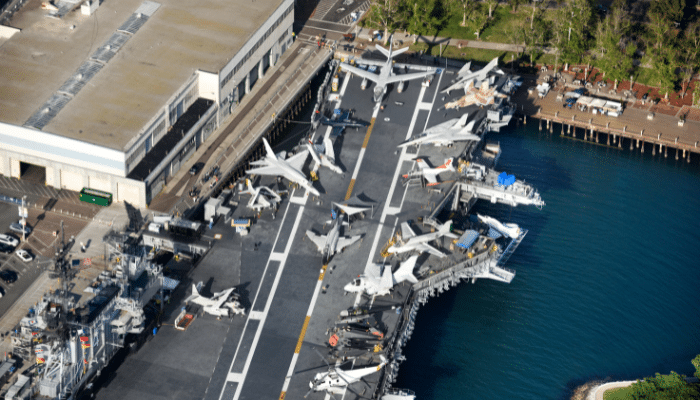
There is also a Battle of Midway Theater, Guided Island Tour, Overnight Adventure, Flight Simulators, Junior Pilot Program, Youth Programs and much more.
Opening Times The Museum remains open from Monday to Sunday, from 10:00 am to 4:00 pm.
Price: Tickets cost USD 26 for adults and USD 18 for youth and veterans with valid ID.
5. Patriots Point; Charleston, South Carolina – USS Yorktown (CV-10)
USS Yorktown was to be named Bonhomme Richard, but she was named Yorktown while being built to honour the Yorktown-class aircraft carrier, the USS Yorktown or CV-5, which sank at the Battle of Midway.
Commissioned in 1943, she was a part of many Pacific Theatre of Operations, which earned her 11 battle stars.
She was decommissioned after World War II ended and was modernised and recommissioned in 1953 as an attack carrier. She served in the Korean War and was upgraded again to add a canted deck, eventually becoming an anti-submarine carrier and serving in the Pacific.
She took part in the Vietnam War, which earned her 5 stars, and as a recovery ship for the 1968 Apollo 8 space mission.
She also starred in the 1970 movie Tora! Tora! Tora!, which portrayed the Japanese attack on Pearl Harbor, and in the 1984 film The Philadelphia Experiment.
She was decommissioned in 1970 and became a museum ship in 1975 at Patriots Point, Mount Pleasant, South Carolina.
About the USS Yorktown Museum
The USS Yorktown Museum has a replica of the Apollo Spacecraft capsule in which visitors can take a ride to the moon and back while listening to radio communication and watching video recorded during the real mission.
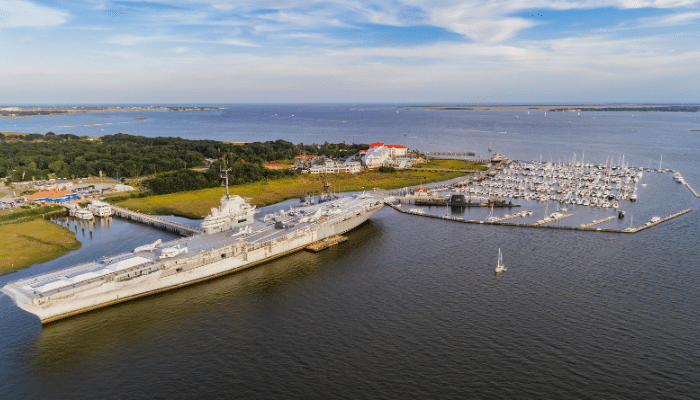
One can also experience the Engine room, which has interactive kiosks. Experience what it felt like to be a technician on this ship during the Second World War in the new Engine Room Experience. Apart from this, there are other exhibits and galleries too.
Ticket Price: For those aged 12+, the ticket costs USD 27, and for those aged between 6-11, it is USD 16, while children under 6 can enter for free. Seniors aged 62+ have to pay USD 19, and the same is applicable for retired military personnel. Veterans, teachers and first responders have to pay USD 21.
Conclusion
These 5 aircraft carrier museum ships embody the pride of the U.S Naval Force. These living museums serve an educative purpose among the people of the country and make them aware of the sacrifices and difficulties faced by the Bravehearts who served onboard these ships and led the country to victory in those difficult times.
You might also like to read-
- Top 15 Aircraft Carriers in the World
- Top 5 Biggest Aircraft Carriers In The World
- What is A Hospital Ship?
- Top 10 Biggest RoRo Ships In The World
- Top 10 Biggest LPG Carriers
Disclaimer: The authors’ views expressed in this article do not necessarily reflect the views of Marine Insight. Data and charts, if used in the article, have been sourced from available information and have not been authenticated by any statutory authority. The author and Marine Insight do not claim it to be accurate nor accept any responsibility for the same. The views constitute only the opinions and do not constitute any guidelines or recommendations on any course of action to be followed by the reader.
The article or images cannot be reproduced, copied, shared, or used in any form without the permission of the author and Marine Insight.
Do you have info to share with us ? Suggest a correction

About Author
Zahra is an alumna of Miranda House, University of Delhi. She is an avid writer, possessing immaculate research and editing skills. Author of several academic papers, she has also worked as a freelance writer, producing many technical, creative and marketing pieces. A true aesthete at heart, she loves books a little more than anything else.
Subscribe To Our Newsletters
By subscribing, you agree to our Privacy Policy and may receive occasional deal communications; you can unsubscribe anytime.



